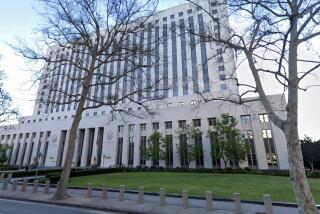Nurse Cites Own Tragedy in Organ Donor Appeals
When Ida Bennett’s teen-age son was killed by a drunk driver in 1980, she found herself asking the same questions about organ donations that she had been answering for others as a hospital emergency room nurse.
“ ‘God, can I really do it?’ ” Bennett recalled asking herself. “It’s a delicate concept. But I knew that my son would want (to donate) since we had discussed it when a friend of his had been killed in an auto accident.”
Bennett now adds her personal experience when counseling family and friends of terminally ill patients at Palomar Memorial Hospital to consider organ and tissue donations. She is among the many nurses and doctors countywide who help provide body parts for transplants and medical research at UC San Diego Medical Center and other institutions both locally and nationwide.
A new California law took effect Jan. 1 that requires hospitals to develop procedures so that all families of dying patients will be aware of the chance to donate organs. Internal organs--heart, liver, pancreas, kidney--as well as cornea, skin tissue and bone are increasingly needed for surgeries as medical technology devises new ways of using them to replace damaged or diseased organs.
San Diego officials express hope that the new law will double the number of donations annually, but they also worry that recent allegations about the diversion of bones from bodies donated to UCSD could temporarily chill the willingness to donate.
Allegations of some bones being diverted over a six-month period to a competing private body tissue bank, although unproven, nevertheless have received widespread publicity and raised the specter of some people profiting from the altruism of others.
The officials who coordinate county donations stress the isolated nature of the charges, saying the allegations should not be allowed to frighten away potential donors.
Under state law, body parts cannot be sold. But when an organ donated in San Diego is needed immediately for a recipient outside the county, hospital tissue banks may recoup processing fees for sending the organ. Part of the present controversy concerns whether private tissue banks need to charge higher processing fees and thus give an impression that such banks are “trading” in bodies.
“I think any setback (in numbers) will be temporary,” said Bennett, adding that counselors must always work hard to dispel misinformation about the process.
“Organ donation tends to scare people, especially those who may be involved with a death for the first time. The biggest fear is whether the body will be treated with dignity, whether there will be disfigurement, especially with a young patient.”
Bennett assures her clients that the body is treated well, that open caskets are still possible, as in the case of her son’s funeral.
And all county organ donation counselors take special efforts to inform people of how the body parts are ultimately used.
“Frequently the donations are the only productive thing that can come out of the death of a family member,” said Dr. Oscar Bronsther, professor of surgery at UCSD and one of two transplant specialists at the medical center.
“Statistics developed nationwide show that we are getting less than 20% of potential donors in San Diego County,” Bronsther said. “Yet when counselors are called in to speak to families, we find that more than 75% of those approached will agree to donate organs. So the key is to make more information available.” (There are 13,000 deaths annually in the county.)
UCSD coordinates donations countywide through the regional Organ and Tissue Acquisition Center. A center counselor will visit with the family or friends of any patient near death to explain the donation process after the patient’s doctor has first outlined general procedures to them.
“We’re available on a 24-hour basis,” said counselor Mikki Masteller. “A family can call us directly, but usually it is first a nurse or a doctor or social worker who calls from the hospital where the death is occurring.”
Although pink donor cards are given to all California drivers along with their operator’s license, few fill them out, according to Norman Greene, spokesman for Mercy Hospital. Mercy recently instructed its nursing staff on ways to solicit donations, emphasizing the sensitivity needed in approaching a family during time of grief.
“It takes very skilled people,” Greene said. “We have those in our chaplaincy department as well as the resources of the (organ and tissue) center to call on.” A donor from Mercy supplied the heart used in the county’s first heart transplant surgery at Sharp Memorial Hospital last fall.
Bennett said that the families of potential donors have a more difficult time dealing with the intricacies of internal organ donations than with corneas or bone. UCSD’s Bronsther said that internal organs must be kept stable with an uninterrupted blood supply until taken from a person who has been declared brain dead. As a result, heart and breathing functions must be maintained by mechanical support during preparations for taking the organs, even though the donor is legally dead.
“That concept is sometimes hard for families to accept,” Bennett said. “With the new law, nurses and doctors must be thoroughly trained in the way to explain this.”
Depending on the age and size of the patient and cause of death, the regional center at UCSD will make medical arrangements to use various organs. Internal organs, such as the heart, liver or kidney, must be used soon after removal from a donor. A heart has only a four-hour survival period between time of removal and use in a transplant. A liver must be used within eight hours and a pancreas within three hours. Kidneys can be used as long as 48 hours after removal. Corneas, skin tissue and bones can be stored for much longer periods and therefore are not as critical to procure immediately after a death.
“There is a national computer network for organ sharing and it is used to locate the best recipients, to match potential donors so that hopefully everyone gets to the right place at the right time,” UCSD’s Masteller said.
Because of the time limits on internal organs, most eligible recipients for donors in San Diego County live within three to five hours’ flying time from San Diego. Potential recipients living in the county have the first opportunity for the organs should size, blood type and other critical factors match.
More to Read
Sign up for Essential California
The most important California stories and recommendations in your inbox every morning.
You may occasionally receive promotional content from the Los Angeles Times.






